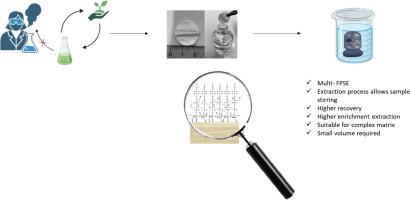3D-printed device for improved membrane-based extraction procedure of xenobiotics in complex matrices
IF 6.5
Q1 CHEMISTRY, ANALYTICAL
引用次数: 0
Abstract
To minimize the environmental and human health impacts of chemical processes, there is growing interest in eco-friendly methods aligned with the principles of Green Analytical Chemistry (GAC). A successful chemical analysis typically involves sample preparation, sampling, separation and analysis, quantification, and data interpretation. Among these, sample preparation plays a crucial role in isolating and preconcentrating target analytes from complex matrices.
In 2014, fabric phase sorptive extraction (FPSE) was introduced as a simplified and greener sample pretreatment method. Building on this advancement and a recent patent, the present study introduces an innovative 3D-printed device designed for use with a range of target analytes and complex sample matrices. Constructed from inert materials, the device features a rigid, modular structure with multiple windows that securely hold various membrane-based extraction materials. These include FPSE membranes, electrospun membranes, and materials derived from adsorbent systems recovered from production or usage waste, as well as permeable molecularly imprinted polymers (MIPs).
The device offers several advantages, including enhanced enrichment factors, compatibility with diverse planar membrane types, and highly customizable selectivity based on membrane configuration and chemistry. Its design also incorporates a built-in slot for a magnetic stirrer, enabling precise control of rotation speed during extraction-even in field conditions using a portable, battery-powered stirrer.
Experimental results unequivocally demonstrate that the new device achieves superior enrichment factors compared to previously validated methods for the same analytes, confirming its effectiveness and potential for broader analytical applications.

3d打印装置,用于改进复杂基质中异种生物的膜基提取程序
为了尽量减少化学过程对环境和人类健康的影响,人们对符合绿色分析化学(GAC)原则的环保方法越来越感兴趣。成功的化学分析通常包括样品制备、取样、分离和分析、定量和数据解释。其中,样品制备在从复杂基质中分离和预浓缩目标分析物方面起着至关重要的作用。2014年,织物相吸附萃取(FPSE)作为一种简化和绿色的样品前处理方法被引入。基于这一进步和最近的专利,本研究引入了一种创新的3d打印设备,设计用于一系列目标分析物和复杂的样品矩阵。该装置由惰性材料制成,具有刚性的模块化结构,具有多个窗口,可安全地容纳各种膜基提取材料。这些材料包括FPSE膜、电纺丝膜、从生产或使用废料中回收的吸附剂系统衍生的材料,以及可渗透的分子印迹聚合物(MIPs)。该装置具有几个优点,包括增强的富集因子,与不同平面膜类型的兼容性,以及基于膜结构和化学的高度可定制的选择性。它的设计还包括一个内置的磁力搅拌器槽,可以在提取过程中精确控制转速,即使在现场条件下使用便携式电池供电的搅拌器。实验结果明确表明,与之前验证过的方法相比,新设备对相同的分析物获得了更好的富集因子,证实了其有效性和更广泛分析应用的潜力。
本文章由计算机程序翻译,如有差异,请以英文原文为准。
求助全文
约1分钟内获得全文
求助全文

 求助内容:
求助内容: 应助结果提醒方式:
应助结果提醒方式:


